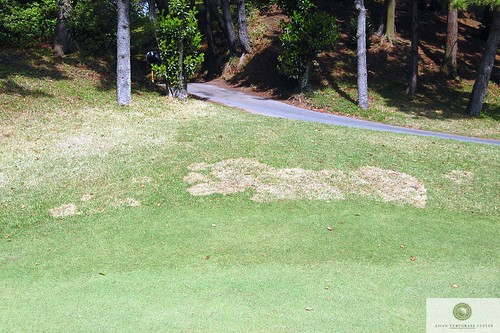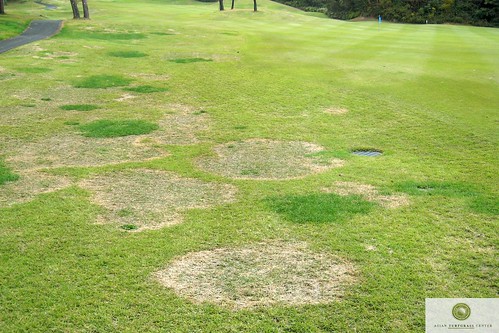I visited a golf course at Kanagawa prefecture last week and saw large patch (caused by Rhizoctonia solani) in some areas of the noshiba (Zoysia japonica) rough. What I find especially interesting is what you see in the picture below. The background is Zoysia japonica and has large patch. The foreground is korai (Zoysia matrella) and the disease symptoms are not apparent at all. The patches just stop at the border between the two species of grass.
I usually see large patch on Zoysia japonica and don't recall seeing it (except in pictures) on Zoysia matrella. Large patch development is observed when air temperatures are around 20° C and the disease is most severe in wet soils. You can see in the photo below the severe large patch of a Zoysia japonica rough where the soil is poorly-drained.
In this case again, however, the disease is prevalent on the Zoysia japonica but the adjacent fairway planted with Zoysia matrella is completely free of damage from large patch. The greenest patches of grass in the rough are perennial ryegrass contamination, also unaffected by the large patch, and growing rapidly at an optimum temperature for cool-season grass.
Control of large patch can require fungicide application to the entire golf course. It is consequently an expensive disease to control, and to my eye, one of the most unsightly. But I see it on Zoysia japonica and not on Zoysia matrella. For the breeders, pathologists, and golf course superintendents who have experience with this disease, do you see the same thing? Why do I see large patch on Zoysia japonica while the adjacent Zoysia matrella seems immune? According to textbooks (such as Tani & Beard's Color Atlas of Turfgrass Diseases), both species of zoysia are susceptible to large patch.
Large Patch on Zoysiagrass
Posted by
Micah Woods
at
12:00 PM
Saturday, April 24, 2010
Labels:
international
,
large patch
,
warm-season
,
zoysiagrass




















3 Responses to “Large Patch on Zoysiagrass”
Micah,
I would take a close look at mowing height. It is unlikely that the variety differences are that exact to line up with the mowing pattern. The higher mown turf may provide a more conducive environment for the disease. To test this idea, extend the fairway height out in a few areas where there is a history of the disease to see if the lower height allows the grass to avoid the disease.
Sincerely,
Larry Stowell
www.paceturf.org
Hi Larry,
Thank you. You always have such wise suggestions!
-Micah
hi ,this is very informative ,i like it turf suppliers,thanks
Post a Comment